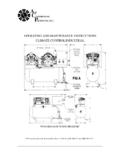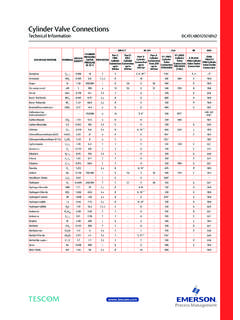Transcription of Operating and Maintenance Instructions - Air …
1 Operating AND Maintenance Instructions . CLIMATE CONTROL/INDUSTRIAL. PERFORMANCE UNDER PRESSURE . 2362 emerson Street Jacksonville, Florida 32207 (800) 394-5575 (904) 396-5575. A Message from the President Air Compressor Products, Inc. (ACP) was established in 1973 to manufacture compressed air systems and related products. We have over forty years experience in the compressed air industry arid our total quality commitment and on-going development provide the background for our technically advanced products. We know that a company's greatest asset is its ability to provide genuine service to its customers.
2 Our mission is to continually improve our products and services in order to meet our customer's needs. This has established Air Compressor Products as an innovative industry leader in the manufacture, development and application of products for compressed air systems. Our products are built for value, safety and long lasting performance. Our modern manufacturing facilities have the flexibility to meet the market needs for both standard and special compressor packages. ACP breathing air and climate control products are recognized worldwide.
3 Our goal is to provide you with products and service second to none. Sincerely, Air Compressor Products, Inc. Greg Walski CEO. FAILURE TO READ THIS MANUAL BEFORE INSTALLING AND. Operating YOUR NEW AIR COMPRESSOR COULD RESULT IN. INJURY, PROPERTY DAMAGE, AND/OR EQUIPMENT FAILURE. FREIGHT DAMAGE. Freight damages do not constitute warranty service. ACP terms are FOB point of shipment (plant), and ACP's responsibility ceases upon delivery of product to carrier and obtaining receipt for same. It Is the responsibility of the receiving customer to file damage or concealed damage claim with the delivering carrier upon receipt or product.
4 1. INDEX. PAGE 1 LETTER FROM ACP PRESIDENT. SAFETY WARNING. FREIGHT DAMAGE. 2 INDEX. 3 INSTALLATION. PREPARING TO START. 4 STARTING. 5 STOPPINGFORMAINTENANCE. LUBRICATION. BELT TENSION ADJUSTMENT. PERIODIC Maintenance CHART. 7. 8 TROUBLESHOOTINGCHART. 12 LONGTERMSTORAGE. 13 TORQUESPECIFICATIONS. 2. INSTALLATION. LOCATION. Locate the compressor in a dry, clean, cool and well ventilated area. If the compressor must be mounted in areas which are poorly ventilated or have dirt, vapors or volatile fumes in the atmosphere, install a remote air intake system.
5 These conditions may cause faulty operation due to clogged intake filters and valves or they can cause moisture to accumulate in the systems air lines. Maximum ambient temperature in which the compressor NOTE: and motor should be operated is 104 F. The compressor must not be installed closer than twelve (12) inches to a wall or to another compressor to allow ample circulation of air across the compressor cylinders and heads. Additional safety can be achieved by locating the pulley system, with the guard, on the wall side. Mounting - Mount the compressor on a concrete pad or floor making certain that the receiver feet are level and that no stress is induced in the legs when the mounting nuts ate tightened, shim feet if necessary.
6 Severe vibrations will result when feet are uneven and drawn tightly to the pad which can lead to welds cracking or fatigue of the receiver. Induction System - Avoid locating the air inlet system where it could ingest toxic, volatile or corrosive vapors, air temperatures exceeding 120 F, water or extremely dirty air. Ingesting any of the above noted atmospheres by the compressor will impair the performance of the equipment. 3. PREPARING TO START. FAILURE TO MAKE THESE RECOMMENDED CHECKS COULD RESULT IN. SERIOUS INJURY, PROPERTY DAMAGE, AND MECHANICAL FAILURE.
7 1. Remove all loose pieces and tools around the compressor installation. 2. Check oil level in crankcase. 3. Check motor and compressor pulley for alignment and tightness on shaft 4. Be absolutely certain that all mounting bolts are tight. 5. Manually rotate compressor through enough revolutions to be certain there are no mechanical interferences. 6. Check belt tension, it should be neither too loose nor too tight. 7. Check all pressure connections for tightness. 8. Check to make sure all safety relief valves are in place. 9. Check to be sure all guards are in place and securely mounted.
8 10. Check fuses, circuit breakers and thermal overloads for proper size. 11. Open all manual shutoff valves (block valves) at and beyond the compressor discharge. 12. After all of the above conditions have been satisfied, jog the starter switch button to check the rotational direction of the compressor, it should agree with the rotation arrow on the unit. STARTING. Follow this procedure for start up of a new installation, after changes to an existing installation have been made, and after service or repairs have been performed. 1. Instructions in addition to those contained within this manual, supplied by manufacturer of support equipment, must also be read and understood before start-up.
9 2. Jog starter button and check compressor rotation. 3. Start compressor and watch for excessive vibration and noises. If either is present, stop compressor and correct. 4. Check air receiver pressure. 5. Manually blow safety relief valve(s). 6. Check operation of controls. 7. Observe general compressor operation closely for first hour and then frequently for next seven hours. If any abnormal conditions exist, stop compressor and correct the problem. 8. After two days of operation, check belt tension, air and oil piping for leaks and crankcase oil level.
10 DUPLEX UNITS: NOTE: It is strongly recommended when starting duplex units both compressors be put on line in the alternating mode. When running only one unit for a long period of time there is a tendency due to heat generated by the Operating compressor for the stand-by compressor to condense moisture in the head causing fist. When both units are Operating equal heat keeps the moisture suspended. 4. STOPPING FOR Maintenance . NEVER ASSUME THE COMPRESSOR IS READY FOR Maintenance OR. SERVICE BECAUSE IT IS STOPPED. THE AUTOMATIC STOP-START.




